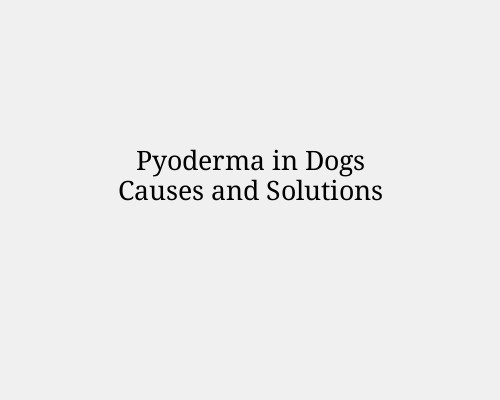Pyoderma in Dogs Causes and Solutions
Introduction
Pyoderma is a common bacterial skin infection in dogs that can cause discomfort and irritation. Recognizing the condition early and addressing it properly is crucial for ensuring your dog’s overall health. In this article, we will explore the causes, symptoms, and effective solutions for managing pyoderma.
What is Pyoderma?
Pyoderma is a term used to describe a bacterial infection of the skin. The condition typically presents with pustules, redness, and sometimes scabs or crusted sores. It can be superficial or deep, depending on how many layers of skin are affected.
Superficial Pyoderma: Involves only the outer layers of the skin and is more common in dogs.
Deep Pyoderma: Affects deeper layers of the skin, often leading to more severe symptoms and complications.
Causes of Pyoderma in Dogs
Several factors can contribute to the development of pyoderma, including:
Underlying Allergies
Dogs with allergies to food, environmental triggers (e.g., pollen, dust mites), or flea bites are at higher risk of developing skin infections due to excessive itching and scratching.
Parasitic Infections
Fleas, ticks, and mites can break the skin barrier, making dogs more susceptible to bacterial infections. Demodex mites, in particular, are a known cause of pyoderma.
Hormonal Imbalances
Endocrine disorders such as hypothyroidism or Cushing’s disease can impair the immune system, leading to recurrent pyoderma.
Poor Hygiene
Lack of proper grooming or failure to clean skin folds (especially in breeds like Bulldogs or Shar-Peis) can promote bacterial growth and infections.
Injury or Trauma
Cuts, scratches, or bites can create openings for bacteria to invade the skin and cause infection.
Weakened Immune System
Dogs with compromised immune systems, often due to age or illness, are at greater risk of developing pyoderma.
Excess Moisture
Dogs that frequently swim or are exposed to excessive humidity can develop skin infections, as moisture can create an ideal environment for bacterial overgrowth.
Recognizing the Symptoms
Common signs of pyoderma in dogs include:
Redness and swelling of the skin
Pustules or pimples
Crusting or scabbing
Hair loss around the affected area
Itching or excessive licking
Foul odor emanating from the skin
Thickened or darkened skin in chronic cases
A veterinarian typically diagnoses pyoderma through:
Physical Examination: Evaluating skin lesions and taking a detailed history.
Skin Scraping or Cytology: Collecting samples to identify the bacteria or rule out other causes like mites or fungal infections.
Allergy Testing: If an underlying allergy is suspected.
Blood Tests: To check for hormonal imbalances or immune deficiencies.
Treatment Solutions
The treatment of pyoderma focuses on addressing both the bacterial infection and any underlying conditions. Common approaches include:
Topical Antibiotics
Medicated shampoos, sprays, or ointments containing chlorhexidine, benzoyl peroxide, or mupirocin can be used to manage mild cases of pyoderma.
Oral Antibiotics
For more severe or deep infections, oral antibiotics may be prescribed. Treatment typically lasts for several weeks to ensure complete resolution of the infection.
Antifungal Treatment (if necessary)
If a fungal infection is also present, antifungal medications may be added to the treatment plan.
Anti-Inflammatory Medications
Corticosteroids or antihistamines may be prescribed to reduce inflammation and itching, especially if allergies are a contributing factor.
Treat Underlying Conditions
Identifying and managing any underlying causes, such as allergies, parasites, or hormonal disorders, is essential to prevent recurrent infections.
Preventing Recurrence
Regular Grooming: Keep your dog clean and well-groomed, paying extra attention to skin folds and moist areas.
Allergy Management: Work with your vet to identify and manage any allergies that may contribute to pyoderma.
Parasite Control: Use flea and tick preventatives to reduce the risk of skin trauma and infection.
Immune Support: Provide a balanced diet and regular veterinary care to support your dog’s immune system.
Monitor Skin: Regularly check your dog’s skin for any signs of irritation or infection, and seek prompt veterinary attention if needed.
Conclusion
Pyoderma in dogs can be uncomfortable and even painful, but with proper diagnosis and treatment, it can be effectively managed. By addressing any underlying causes and maintaining good hygiene and skin care, you can reduce the risk of future infections and keep your dog happy and healthy. If you suspect your dog has pyoderma, consult your veterinarian for a tailored treatment plan.







